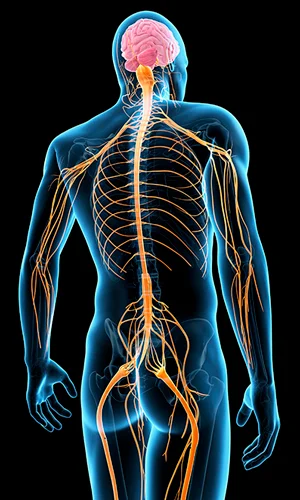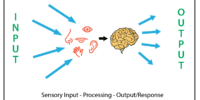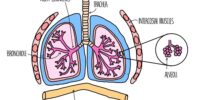What Is The Nervous System? Brain, Spinal Cord, And Nerves

The nervous system is a complex network of cells, tissues, and organs that coordinates and controls the functions of the body. It is responsible for receiving and processing information from the environment, transmitting signals throughout the body, and carrying out complex behaviors and movements.
The nervous system is divided into two main parts: the central nervous system (CNS), which includes the brain and spinal cord, and the peripheral nervous system (PNS), which includes all the nerves that connect the CNS to the rest of the body.
The nervous system plays a crucial role in maintaining homeostasis, which is the bodys ability to maintain a stable internal environment despite changes in the external environment. It regulates a wide range of functions, including movement, sensation, perception, thought, and emotion.
Understanding the anatomy and function of the nervous system is essential for diagnosing and treating nervous system disorders, such as Alzheimers disease, Parkinsons disease, and multiple sclerosis. In this article, we will explore the structure and function of the brain, spinal cord, and nerves, as well as the communication between neurons, the autonomic nervous system, and common nervous system disorders.
Additionally, we will provide tips and strategies for maintaining nervous system health.
Key Takeaways
- The nervous system coordinates bodily functions, receives and processes information, and maintains homeostasis.
- The nervous system is divided into the central nervous system (CNS) and the peripheral nervous system (PNS).
- The brain serves as the control center for the nervous system, while the spinal cord serves as a pathway for signals to travel between the brain and the rest of the body.
- Neurons communicate through synaptic transmission, which can be altered by drugs influencing neurotransmitters.
The Role of the Nervous System in the Body
The nervous system plays a crucial role in the body by coordinating and controlling various bodily functions through communication between the brain, spinal cord, and nerves.
The brain serves as the control center for the nervous system, receiving and processing information from the senses and sending out signals to the rest of the body to respond accordingly.
The spinal cord serves as a pathway for signals to travel between the brain and the rest of the body, while the nerves extend throughout the body to transmit signals to and from different organs, muscles, and tissues.
The nervous system is responsible for numerous bodily functions, including movement, sensation, thought, and emotion.
For example, the motor neurons in the nervous system control voluntary and involuntary movements, such as walking, running, and breathing.
Sensory neurons, on the other hand, detect and transmit sensory information, such as touch, sight, and sound, to the brain for processing.
Additionally, the nervous system plays a crucial role in cognitive processes such as memory, attention, and language.
Overall, the nervous system is essential for maintaining homeostasis and ensuring that the body responds appropriately to internal and external stimuli.
Anatomy of the Brain: Structure and Functions
An understanding of the various regions and functions of the cerebral cortex is crucial to comprehending the complex nature of the brain’s anatomy.
The cerebral cortex is the outermost layer of the brain and is divided into four lobes: the frontal lobe, parietal lobe, temporal lobe, and occipital lobe.
Each lobe is responsible for different functions.
The frontal lobe, located at the front of the brain, is responsible for decision-making, planning, and problem-solving.
The parietal lobe, located at the top of the brain, is responsible for processing sensory information from the body such as touch and temperature.
The temporal lobe, located on the sides of the brain, is responsible for processing auditory information and is also involved in memory formation.
Finally, the occipital lobe, located at the back of the brain, is responsible for processing visual information.
Apart from the cerebral cortex, the brain also contains other important structures such as the cerebellum, brainstem, and thalamus.
The cerebellum, located at the back of the brain, is responsible for coordinating movement and balance.
The brainstem, located at the base of the brain, controls basic functions such as breathing and heart rate.
The thalamus, located in the center of the brain, acts as a relay station for sensory information.
Overall, the brain is a complex and intricate organ that is responsible for controlling all bodily functions and processes.
The Spinal Cord: A Vital Link in the Nervous System
Vital information is transmitted throughout the body through a crucial pathway that runs from the brain to the rest of the body. This pathway is known as the spinal cord.
The spinal cord is a long, thin, tubular bundle of nerve fibers that extends from the base of the brain down to the lower back. It is protected by the vertebrae, which are the bones that make up the spine.
The spinal cord plays a vital role in the nervous system as it serves as a link between the brain and the rest of the body. It is responsible for transmitting messages between the brain and the various parts of the body, allowing for movement, sensation, and reflexes. The spinal cord is also responsible for controlling many of the body’s involuntary functions, such as breathing, heartbeat, and digestion.
Overall, the spinal cord is an essential component of the nervous system, and any damage to it can have severe consequences on a person’s health and well-being.
Functions of the spinal cord:
- Transmit messages between the brain and the rest of the body
- Control many of the body’s involuntary functions, such as breathing, heartbeat, and digestion.
Types of Nerves and Their Functions
Understanding the diverse roles played by different types of nerves in the human body can evoke a sense of awe and appreciation for the complexity of the nervous system. Nerves are the pathways that allow communication between the central nervous system (CNS), which includes the brain and spinal cord, and the rest of the body. There are three main types of nerves: sensory nerves, motor nerves, and mixed nerves.
Sensory nerves are responsible for transmitting information from the body’s sensory organs, such as the eyes, ears, nose, and skin, to the CNS. Motor nerves, on the other hand, are responsible for transmitting information from the CNS to the muscles and organs of the body, allowing for voluntary and involuntary movement. Mixed nerves contain both sensory and motor fibers, allowing for bidirectional communication between the CNS and the body. Understanding the functions of these different types of nerves can provide insight into how the nervous system works as a whole.
| Type of Nerve | Function |
|---|---|
| Sensory Nerves | Transmit sensory information from the body’s sensory organs to the CNS. |
| Motor Nerves | Transmit information from the CNS to the muscles and organs of the body for voluntary and involuntary movement. |
| Mixed Nerves | Contain both sensory and motor fibers, allowing for bidirectional communication between the CNS and the body. |
Using a table to visualize the different types of nerves and their functions can help to evoke emotion in the audience by demonstrating the intricate and interconnected nature of the nervous system. It highlights the complexity of the human body and the importance of each component working together to maintain proper function. The nervous system is a remarkable and intricate system that plays a vital role in our everyday lives, and understanding the different types of nerves and their functions is just one small piece of the puzzle.
How Neurons Communicate: Synapses and Neurotransmitters
The communication between neurons is a complex process that involves the release of neurotransmitters at the synapse. When an action potential reaches the end of an axon, it triggers the release of neurotransmitters into the synaptic cleft, the small gap between the sending neuron’s axon terminal and the receiving neuron’s dendrite or cell body. This process is called synaptic transmission and involves several steps:
- Synthesis and storage: The neurotransmitters are synthesized and stored in vesicles in the axon terminal until they are needed.
- Release: When the action potential reaches the axon terminal, it triggers the release of neurotransmitters into the synaptic cleft.
- Receptor binding: The neurotransmitters bind to receptors on the receiving neuron’s dendrite or cell body.
- Inactivation: The neurotransmitters are either broken down or taken back up into the sending neuron for reuse.
Understanding the process of synaptic transmission is crucial to understanding how the nervous system works and how drugs and other chemicals can affect it. By influencing the release, binding, or inactivation of neurotransmitters, drugs can alter communication between neurons and have a wide range of effects on behavior and physiology.
The release of neurotransmitters at the synapse is a complex process that involves several steps. This process is crucial for communication between neurons and understanding it is essential for understanding the functioning of the nervous system.
The Autonomic Nervous System: Controlling Involuntary Functions
Regulating involuntary bodily functions, such as heart rate and digestion, is a critical function of the autonomic nervous system. This system is responsible for controlling and coordinating the activity of smooth muscle, cardiac muscle, and glands, all of which are essential for maintaining homeostasis in the body.
The autonomic nervous system is divided into two branches: the sympathetic nervous system and the parasympathetic nervous system. These two branches have opposing effects on the body and work together to maintain a delicate balance between different bodily functions.
The sympathetic nervous system is responsible for the ‘fight or flight’response, which prepares the body for action in response to perceived danger or stress. This response is characterized by an increase in heart rate, blood pressure, and respiration, as well as a decrease in digestion and other non-essential functions.
The parasympathetic nervous system, on the other hand, is responsible for the ‘rest and digest’response, which promotes relaxation and recovery after a period of stress. This response is characterized by a decrease in heart rate, blood pressure, and respiration, as well as an increase in digestion and other essential functions.
Overall, the autonomic nervous system plays a crucial role in maintaining the homeostasis of the body, and any dysfunction in this system can lead to a variety of diseases and disorders.
Common Nervous System Disorders and their Treatments
Various disorders affecting the functioning of the autonomic nervous system have been identified, with treatments ranging from medication to lifestyle changes.
One of the most common disorders is orthostatic hypotension, which is characterized by a sudden drop in blood pressure upon standing up. This can lead to dizziness, fainting, and even falls.
Treatment options for orthostatic hypotension include increasing salt and water intake, wearing compression stockings, and taking medications such as fludrocortisone and midodrine.
Another disorder affecting the autonomic nervous system is autonomic neuropathy, which is damage to the nerves that control involuntary functions such as heart rate and digestion. This can occur as a result of other conditions such as diabetes or alcoholism.
Treatment options for autonomic neuropathy include managing the underlying condition, taking medications such as alpha blockers or anticholinergics, and making lifestyle changes such as avoiding alcohol and smoking.
It is important to seek medical attention if experiencing any symptoms of autonomic nervous system disorders, as they can greatly affect quality of life and lead to serious complications.
Maintaining Nervous System Health: Tips and Strategies
Maintaining healthy habits such as regular exercise, maintaining a balanced diet, and reducing stress can promote optimal functioning of the autonomic nervous system. The autonomic nervous system is responsible for regulating involuntary functions that occur without conscious effort, such as heart rate, breathing, and digestion.
Exercise can increase blood flow to the brain and improve cognitive function, while a balanced diet rich in nutrients can support the production of neurotransmitters that regulate mood and behavior. Additionally, reducing stress through practices such as meditation or mindfulness can help regulate the body’s stress response, which can otherwise have negative effects on the nervous system.
In addition to these lifestyle habits, getting enough sleep and avoiding excessive alcohol and drug use can also help maintain nervous system health. Sleep is crucial for the restoration of the body and brain, and lack of sleep can lead to fatigue, impaired cognitive function, and reduced immune function. Excessive alcohol and drug use can damage neurons and disrupt neurotransmitter function, leading to a variety of neurological disorders.
Ultimately, maintaining a healthy nervous system requires a holistic approach that takes into account all aspects of physical and mental health, including regular exercise, a balanced diet, stress reduction, sleep hygiene, and avoiding harmful substances.
Conclusion
In conclusion, the nervous system is a complex network of organs, tissues, and cells that work together to control and coordinate all the body’s functions.
The brain serves as the central control center, while the spinal cord acts as a vital link between the brain and the rest of the body.
The nerves, on the other hand, transmit electrical signals to different parts of the body, allowing for communication and coordination.
While the nervous system is a highly sophisticated and efficient system, it is also vulnerable to damage and disease.
Common nervous system disorders include Alzheimer’s disease, Parkinson’s disease, multiple sclerosis, and epilepsy.
However, with proper care and treatment, many of these conditions can be managed, and individuals can lead healthy and fulfilling lives.
Maintaining a healthy lifestyle, including regular exercise, a balanced diet, and stress management, can also help to promote optimal nervous system health.







